When Mohamed Bouazizi, a Tunisian fruit and vegetable vendor, set himself on fire on 17 December 2010, he triggered a period of unrest that would eventually unseat the country's president Zine El Abidine Ben Ali. Bouazizi’s self-immolation in front of a government building in the town of Sidi Bouzid not only led to the downfall of the Tunisian leader, but also set off protests that engulfed much of the Middle East as people rose up against oppressive regimes. These uprisings—across Tunisia, Morocco, Syria, Libya, Egypt and Bahrain—formed part of the revolutionary pro-democracy movement known as the Arab Spring. Ten years on, we ask artists, writers and cultural leaders from the Middle East, or who specialise in the region, about the impact of the Arab Spring; its legacy for arts and culture; and, crucially, what the future looks like for its artists and institutions.

Left: artist Manal Al Dowayan; right: protests in Tahrir Square, Cairo, on 1 April 2011 Tahrir: Lilian Wagdy
Manal Al Dowayan
Saudi Arabian artist
What is your lasting memory of the Arab Spring?
I had moved to Cairo for an artist residency at the Town House Gallery in September-December 2011. I was very excited to arrive in Egypt during the political revolution (I don't use the term Arab Spring) of the country. I had watched this movement on TV, I remember my mother praying for my safety, there was a lot of fear of the unknown as I left Saudi Arabia. Once I was on the ground and living in Cairo, a city that had no president or official structure, I felt very safe and cared for by Egyptians. Actually the city was so densely populated that the revolution was happening in one part of the city and in the other part there was a football game in a packed stadium. Life continues always in Cairo!
What is the legacy of the Arab Spring for arts and culture?
I did not make any art during the political uprising in Egypt. Instead I ran a workshop with 70 emerging artists where I made the participants start a work and then hand it over to the next person to work on, respecting the image that exists and adding to it as they see fit. I guess I felt there were small divisions in society that I was seeing that compelled me to address this issue. I was often invited into the homes of Egyptians for lunches and dinners and I always witnessed that the families were divided between those who were pro-Hosni Mubarak and those who were against him; the debates were heated and emotional. That might have been the trigger for me.
What does the future look like for arts and culture in the region?
I think the power of the very youthful population of the whole of the Arab world has become very apparent and recognised as an energy that needs care and a vision. Some countries have embraced this new energy and some have ignored it.
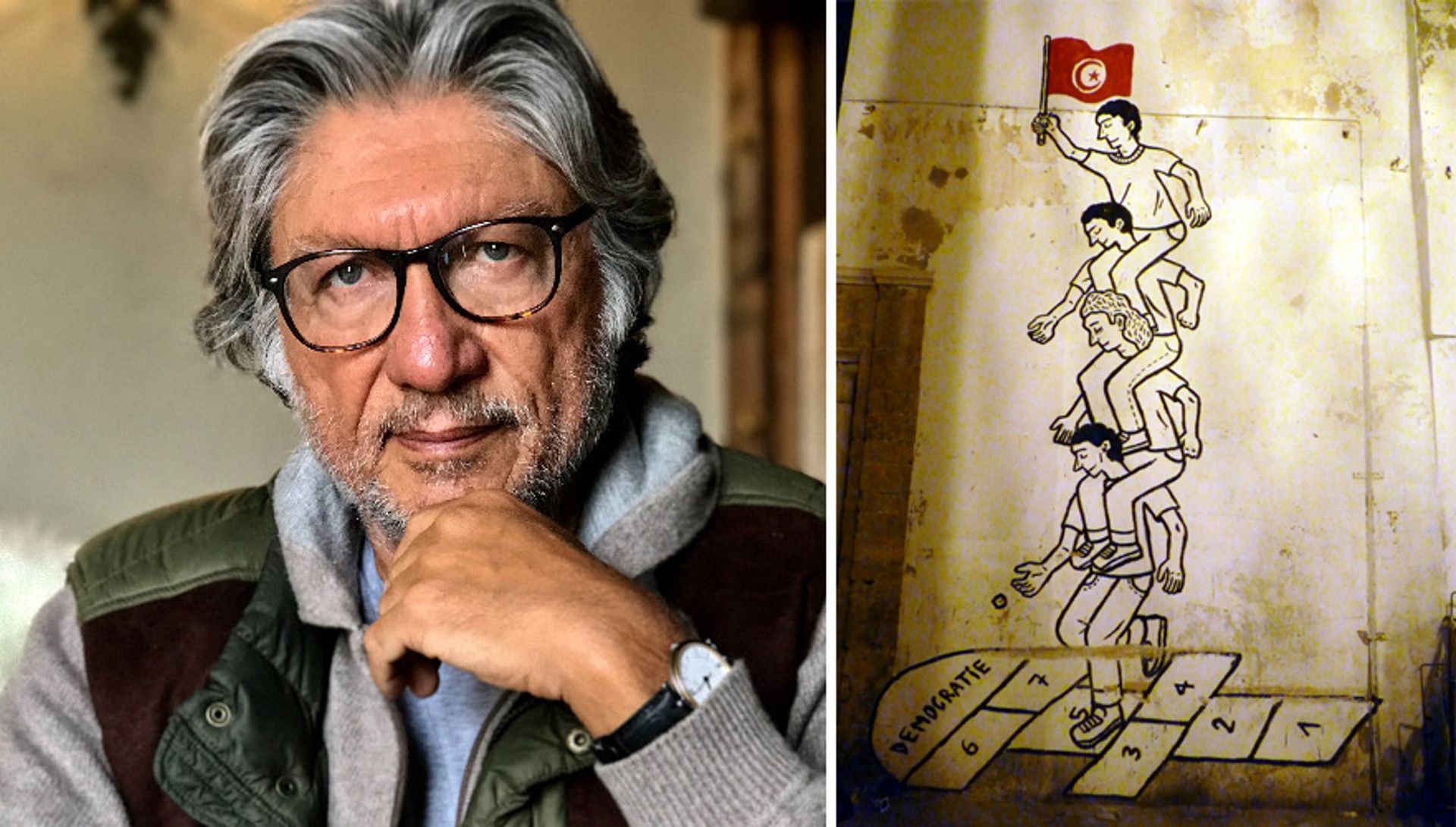
Left: Hossein Amirsadeghi; right: a piece of street art in Tunis from August 2011 expresses the complicated steps towards democracy in Tunisia Street art: SupapleX
Hossein Amirsadeghi
Writer and editor; co-author of Art & Patronage: The Middle East, Transglobe Publishing
What is your lasting memory of the Arab Spring?
What has stayed with me all this time more than anything was the extraordinary eruption of hope amongst all classes, especially the young, for the realm of the possible set against ingrained limitations.
What is the legacy of the Arab Spring for arts and culture?
Nine years ago almost to the week, I predicted at the A&P Summit in London that despite all the hoopla and celebrations around the Arab Spring, the fundamental groundwork for long-term pluralism was beyond the grasp of Arab societies incapable of delivering the very basic needs of its citizens, let alone meeting the aspirations of community political consensus, and the needs of the demographic youth bulge. The groundwork for such is education, economic independence and social cohesion marked by progress.
What does the future look like for arts and culture in the region?
The future looks bleak, unrepentant, periodically explosive and intrinsically unreformable as things stand... a state of stasis. The only hope for artists in the region is where it serves the regime, for propaganda and projection of a liberal, creative stance, which is strictly controlled. Real art demands critical visual discourse. Criticism is frowned upon, dissent crushed, religion taboo, society off limits—where does one go except to toe the guardrails?
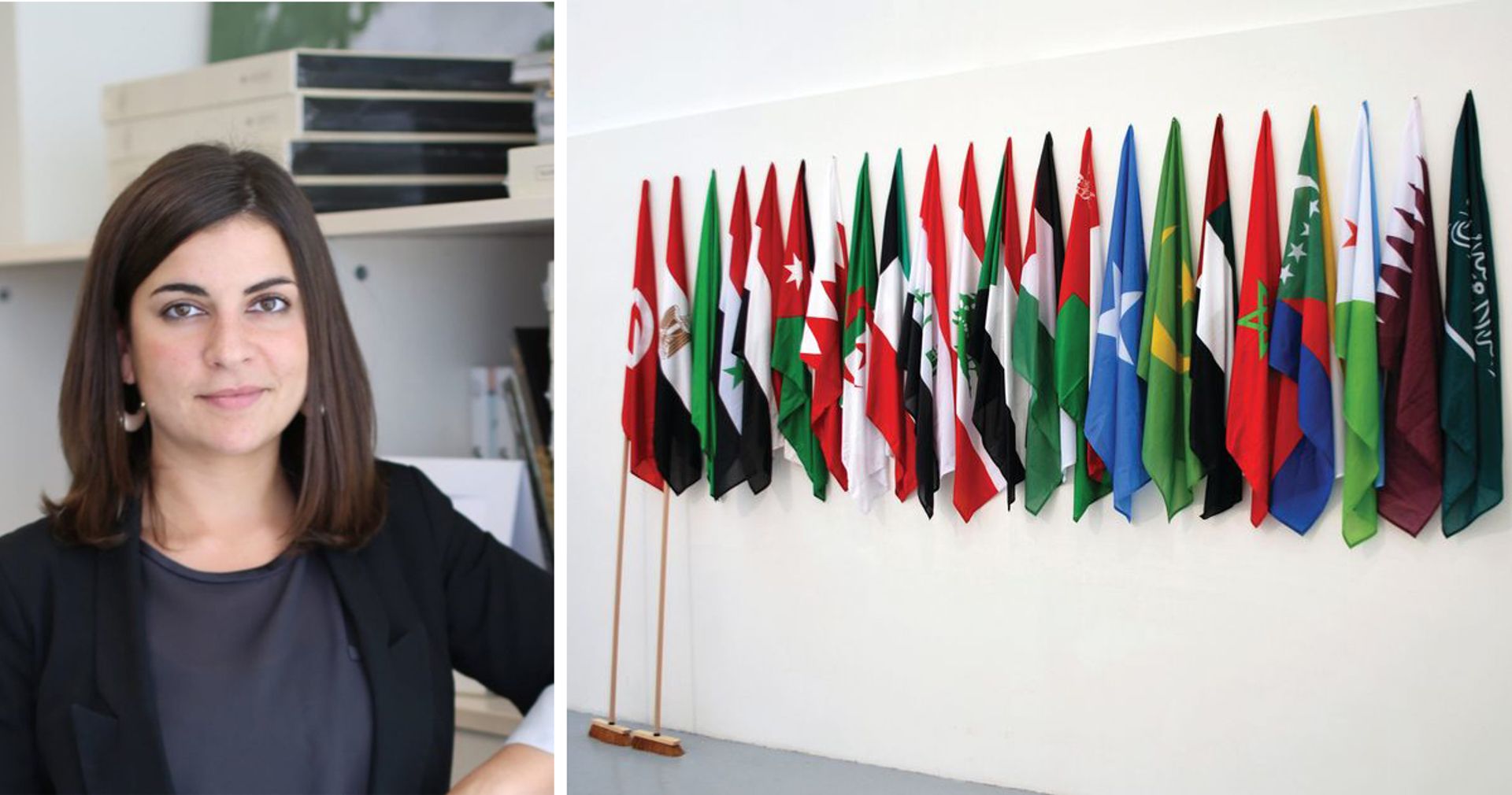
Left: Amani Hassan; right: Mounir Fatmi's The Lost Springs (2011) Fatmi: Courtesy of the artist and Galerie Hussenot, Paris
Amani Hassan
Acting executive director and programme director of the Arab British Centre, a cultural organisation that works to further understanding of the Arab world in the UK
What is your lasting memory of the Arab Spring?
A few art works stand out but in particular The Lost Springs by Moroccan artist Mounir Fatmi, which was an installation of flags representing the 22 states of the Arab League, with those going through revolutionary protests hanging on brooms.
What is the legacy of the Arab Spring for arts and culture?
The Arab Spring went beyond the political revolution, it paved the way for new cultural initiatives across the Arab world, many of them completely detached from government. The legacy of the Arab Spring is yet to be known as it is very much alive today in many parts of the Arab world. Although it positively encouraged politically loaded forms of artistic expression focused on anti-establishment and anti-authoritarianism narratives, censorship is still a problem in many countries.
What does the future look like for arts and culture in the region?
Seeing how much has happened in the last ten years, one can only hope that the burgeoning arts and culture scene will continue to grow. There is an increasing interest from governments to support local artists which is very encouraging. Of course there will be major disparities between countries—the Gulf has built more museums than most other regions in the world over the last ten years, while the civil war in Syria has decimated funding for the arts.

Left: Othman Lazraq; right: the opening of the exhibition The Future of a Promise at the Venice Biennale in 2011 Lazraq: © Mehdi Mariouch; exhibition: Alex Maguire
Othman Lazraq
Director of Fondation Alliances, a non-profit organisation dedicated to cultural development in Morocco, and president of the Museum of African Contemporary Art Al Maaden (MACAAL) in Marrakech
What is your lasting memory of the Arab Spring?
Beyond astonishment and tension, I remember the profusion of creativity generated by these political events, in proportions never seen before in these countries, as well as the highlighting of these artistic scenes that have been little shown in the West before. One thing that struck me was the breakthrough of Arab artists at the 54th edition of the Venice Biennale in November 2011, which had never hosted so many. The exhibition The Future of a Promise gathered 22 of them, from Morocco to Saudi Arabia.
What is the legacy of the Arab Spring for arts and culture?
The Arab Spring gave artists in these regions a new sense of freedom that led to a liberation of creativity and a more assertive, daring artistic expression. It was also the emergence of a whole new scene that was politically engaged. But above all, it increased the global interest for artists from the Middle East and North Africa (MENA), which are now quite popular and becoming more mainstream. On a negative note, many cultural initiatives in the region were shut down and some artists fled their countries.
What does the future look like for arts and culture in the region?
These events created solid bridges between the art scenes of MENA countries, allowing synergies and dialogues that we are committed to growing. Social media networks are also definitely a key asset; they break borders and facilitate discoveries, exchanges and links. As for us, we are lucky in Morocco because arts and culture have always been a priority.
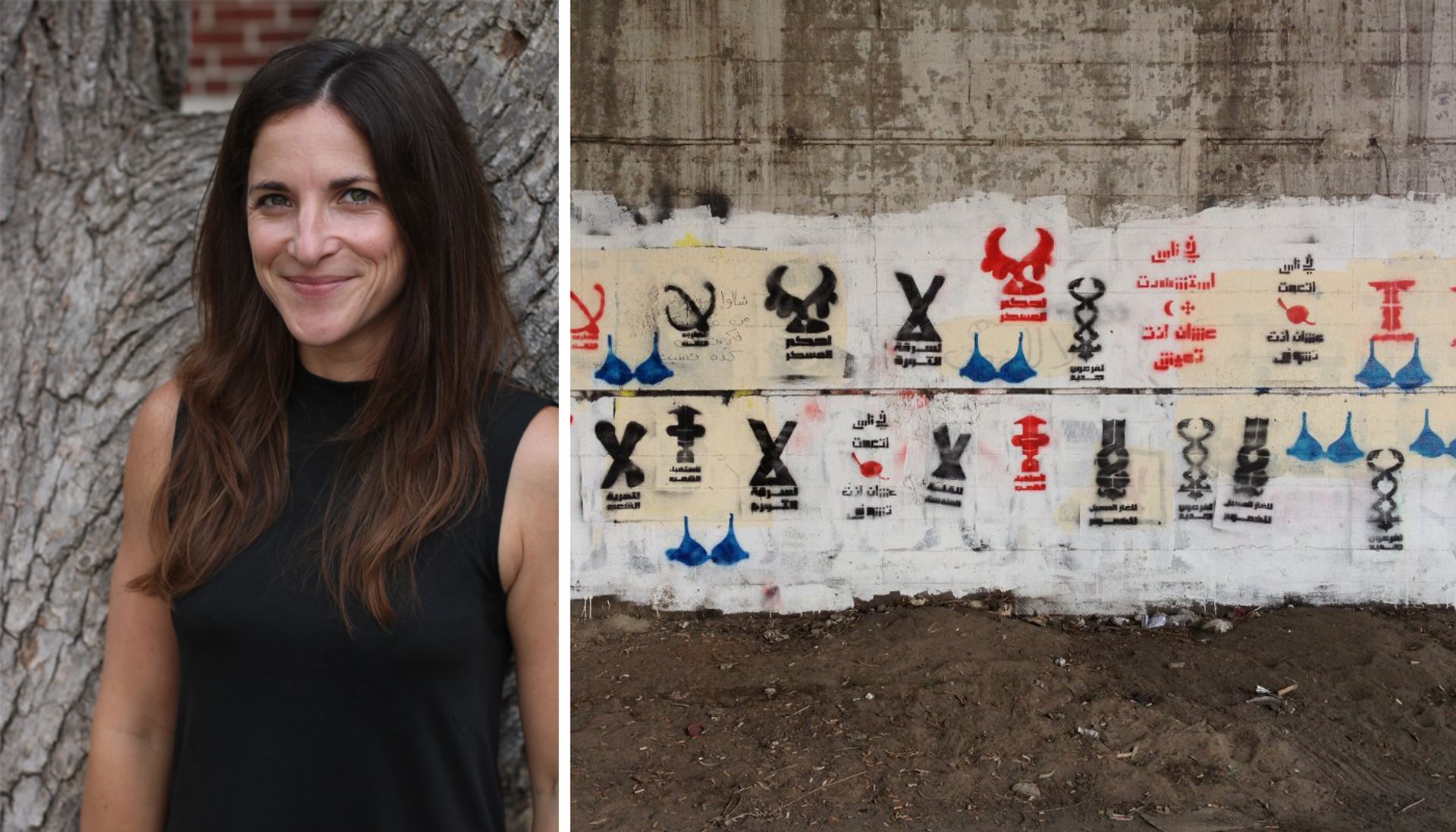
Left: Sascha Crasnow; right: Bahia Shehab’s stencils, including the blue bra Crasnow: Robby Griswold
Sascha Crasnow
Lecturer in Islamic Arts, University of Michigan
What is your lasting memory of the Arab Spring?
My lasting art-related memory is Bahia Shehab’s stencils of the blue bra, in reference to sitt al-banat [the best of all girls] the name given to the woman who was dragged by army soldiers through the streets by her abaya exposing her torso and blue bra.
What is the legacy of the Arab Spring for arts and culture?
I’m not sure that I have a great answer for this one. For many the most memorable thing about the Arab Spring is its use of social media—so I think perhaps one of the legacies is how art (in the case of the Arab Spring mostly graffiti and street art) can continue to circulate and have an impact beyond its time in the physical space it originally occupies. This is not something that was unknown before this, of course, but it was something to think about as part of how images disseminated internationally as the events unfolded. Murals and stencils and graffiti adorned virtual walls even after they had been whitewashed. But as they move through these various virtual spaces, it is interesting to think about how their meaning and impact may or may not change as they are removed from their original context and placed into new ones.
What does the future look like for arts and culture in the region?
I believe it is bright. Greater international attention in the past few decades on contemporary art, in particular, from the region and its diasporas has created more opportunities for artists and for audiences to gain exposure to their work, and for more investments in the arts, both locally and from abroad. This is not to say that all is rosy—there have been a number of incidents that have damaged the arts in the region over the past decade, from censorship and governmental shutdown of institutions (as with the Townhouse Gallery in Cairo); to continued civil violence (such as in Syria); to the devastation of contemporary arts institutions in Beirut because of the blast last year. However, none of this has stopped artists and arts institutions from continuing to make and show work and, in our current pandemic world, the move to virtual has at times allowed for greater international access to events, talks, conferences and workshops.
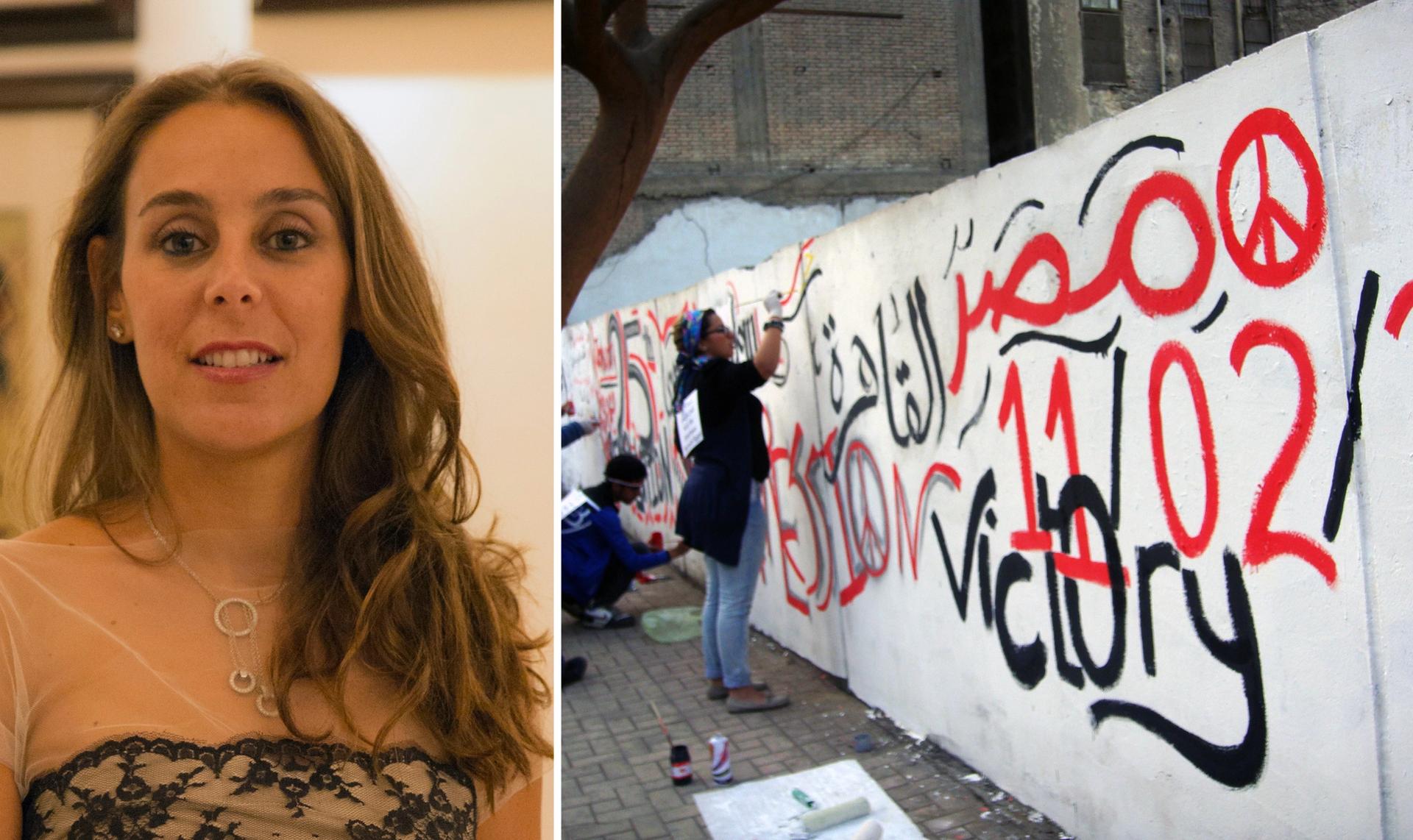
Left: Nadine Abdel Ghaffar; right: people painting on the walls in Cairo on 12 February 2011
Nadine Abdel Ghaffar
Founder of Art D’Egypte, a company that aims to promote Egyptian art and heritage
What is your lasting memory of the Arab Spring?
A lasting art-related memory is the graffiti. People turned to the streets in order to express themselves, art became democratised and accessible; by the people and for the people.
What is the legacy of the Arab Spring for arts and culture?
It showed us how resilient our community is and how we were all able to bounce back in such a short time. When people and nations are faced with adversity, the community often turns to art for expression and most importantly as a coping mechanism.
What does the future look like for arts and culture in the region?
The future is looking vibrant, and seemingly full of arts and culture. Every aspect of society is working hard to revive the soul of the community through the arts.
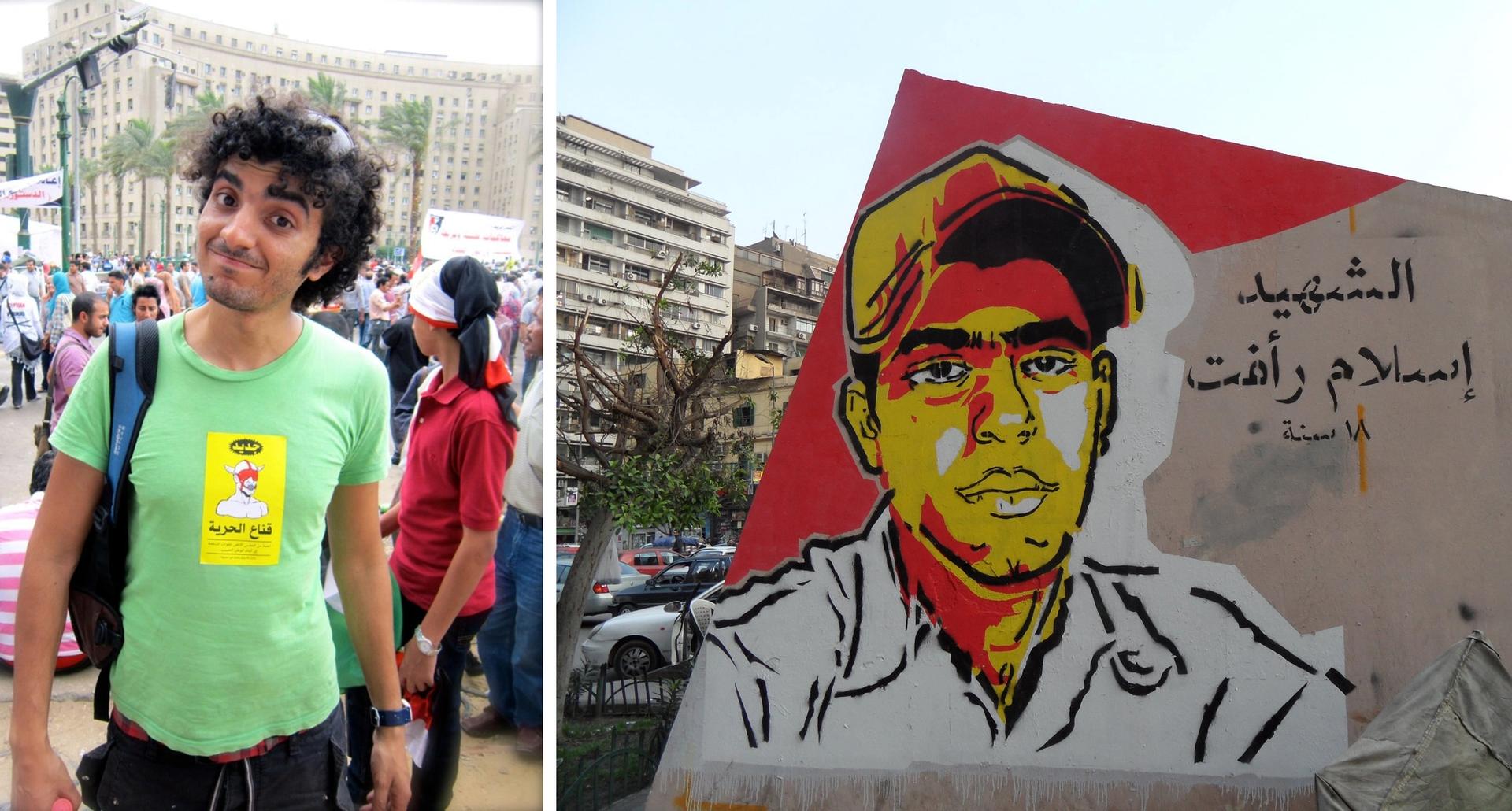
Left: artist Ganzeer and, right: his memorial portrait for 18-year-old Islam Rafat Zinhoum who killed by a security truck on 28 January 2011. It was painted in March 2011 close to Tahrir Square Ganzeer: Gigi Ibrahim; mural: Alisdare Hickson
Ganzeer
Egyptian artist who rose to mainstream fame with his murals painted during the Cairo revolution
What is your lasting memory of the Arab Spring?
The movement of hundreds of thousands of bodies moving together. The eloquence and poignance of chants, with new ones being invented almost every day. Kiosks giving out free water to protestors, the humour scrawled on signs and posterboards, and the reclaiming of public space by people, art and music. Smouldering armoured vehicles and police officers shedding their uniforms and saying "we're sorry". The rattle of spraycans before being used on military tanks, scrawling "No Mubarak" before soldiers could take notice. Thousands of voices chanting "we won't go, he must go". Makeshift clinics set up by med students and doctors near the "front lines" of clashes, tending to the wounded, and young punks with motorcycles becoming de facto ambulances. Young boys writing their mothers phone numbers on their arms, before disappearing into thick clouds of US-made tear gas without knowing if they would ever come out. I remember hundreds of people sweeping streets and scrubbing statues the minute they thought the revolution was over, and a dozen different youth groups forming coalitions to discuss the path forward before it was all taken away.
What is the legacy of the Arab Spring for arts and culture?
There is not much of legacy, unfortunately. I see the "art world" mostly interested in capitalising on the art of "the Arab Spring" as a historical capsule that can be commodified, packaged and sold to wealthy collectors and institutions interested in keeping a "piece of it", and not so much (or not enough, rather) of an inclination to push for more art influenced by the spirit of the Arab Spring, and that is art as an active agent of social change.
What does the future look like for arts and culture in the region?
The future looks like however we want it to look like. As long as we want it (and act it) bad enough. Isn't that how the future becomes present?
UPDATE (10 February)
Fatenn Mostafa
Author of Modern Art in Egypt: Identity and Independence 1850-1936 (I. B. Tauris / Bloomsbury)
What is your lasting memory of the Arab Spring?
The Arab Spring feels so far away. Yet, it seems like yesterday. It is difficult to describe in words the feelings of euphoria and the adrenaline that rushed through our veins. We believed that everything was possible. People of all strata, religion, gender, and ideology were truly united as one. We were strong and invincible. Or so we thought.
The two weeks between 25 January and 11 February were a mix of fantasy and tragedy. Fantasy because we witnessed the power of the people. The unforgettable chants and marches. The electrifying bonding. The explosive creativity across all art forms. A tragedy because I lost my father when his neighborhood watch was attacked by thugs on the night of 2 February. They all survived, except him. He was too old to run for his life. But his death didn’t go in vain. He exemplifies the meaning of courage and determination.
What is the legacy of the Arab Spring for arts and culture?
Some say the Arab Spring is dead. They are wrong. It is alive, only in different ways. It is still alive in the hearts and souls of millions of Arabs. Remember that today’s movers and shakers were in their teens back in 2011. They may not have grasped it then, but they sure do now—that their parents fought for their freedom. Also, the Arab Spring broke many taboos and put on the table discussions that were unfathomable pre-2011. Egyptians matured and are now aware of their rights. Their voice can make a difference. They also know that, if and when, then they can. All this is paving the way for a brighter future.
If we consider the current situation a zero-sum game around the region, history taught us that drastic changes need to go through different phases. Similar to the 1919 Revolution, the curve will go back up again. At the right time. So, what some may consider as negative aspects are, in fact, a progression towards the end goal. The end goal being democracy, freedom, bread, and social justice. It is a matter of time.
What does the future look like for arts and culture in the region?
The rather illiberal situation around the world is unsustainable in the long term. Many ‘Western democracies’ for example, have failed the test of time. Some were unable to stop the rise of right-wing ideologies; others failed to manage the global pandemic. In fact, Covid-19, just like the Arab Spring, has opened our eyes to many things. If we want to talk about the future of the Arab world, specifically, post-2011, I see a surge in the number of educated young men and women taking gradual control. We see a significant rise in successful (business and social) entrepreneurship; we know the influence social media has on governments—or how much they fear it—and public opinion.
However, one major pitfall or hurdle remains and it is the flawed education system for the masses. That is where our fight must be geared towards. Education does not mean teaching geography for example. All this is accessible at the tip of everyone’s finger. But instead, opening the mind, teaching critical thinking, telling the truth about our histories, teaching arts the right way. Simply, enabling the mind to think freely.


